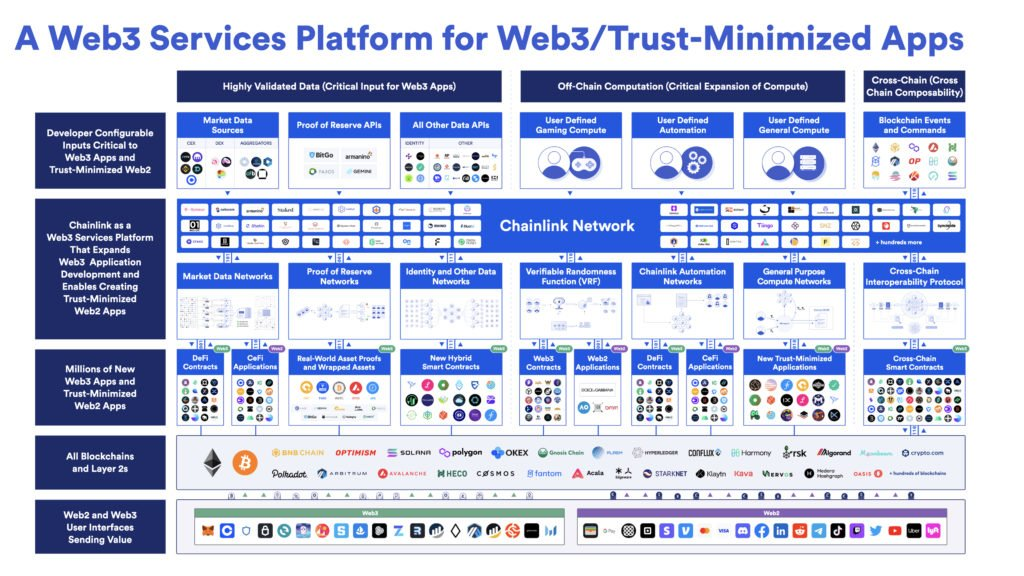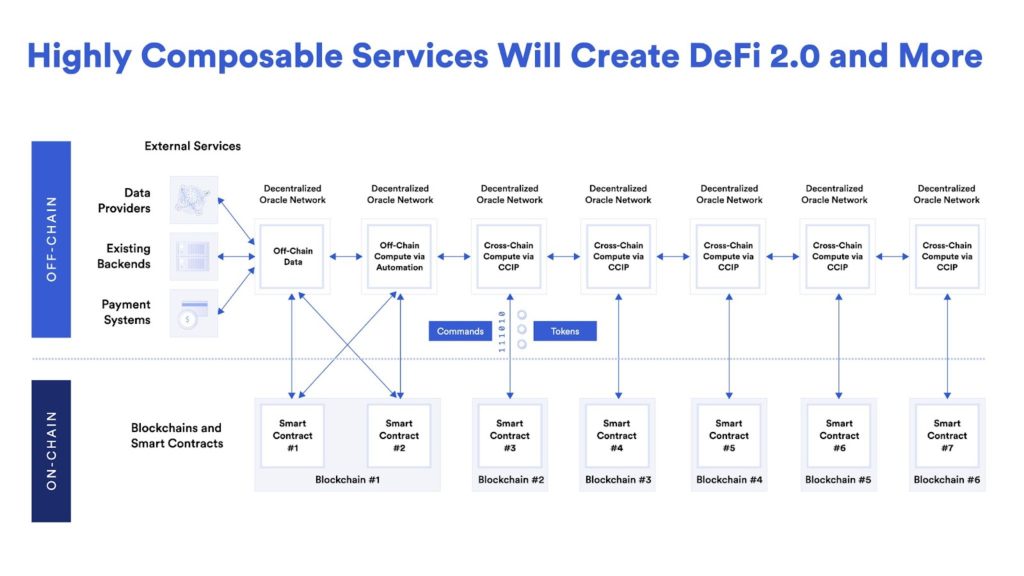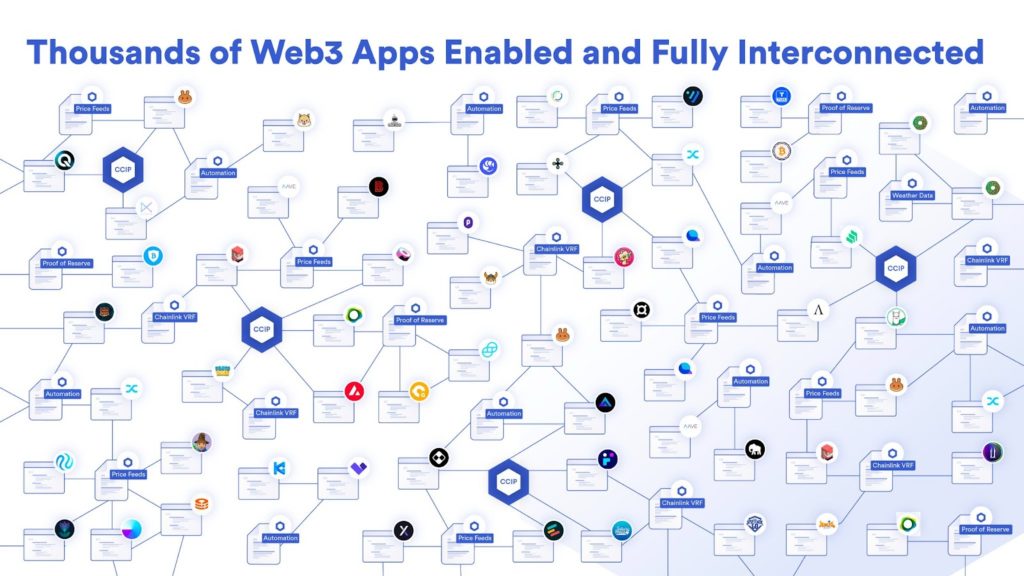Chainlink: The Web3 Services Platform for a Hyper-Connected Blockchain Ecosystem
Chainlink services underpin the Web3 ecosystem with mission-critical infrastructure that powers, secures, and connects innovative applications across DeFi, insurance, gaming, NFTs, and other key verticals. Chainlink Data Feeds was the first service to launch, underpinning the growth of the DeFi ecosystem and helping to secure tens of billions worth of value.
This post, based on Chainlink Co-Founder Sergey Nazarov’s SmartCon 2022 Keynote, encapsulates how Web3 applications are integrating several Chainlink services for enhanced utility, the key role of Chainlink services in enabling the creation of advanced applications, and how cross-chain communications infrastructure powered by Chainlink is being built to enable a highly interconnected and composable Web3 ecosystem that secures hundreds of trillions worth of value.
Building a Web3 World Powered by Cryptographic Truth
Web3 Services for Trust-Minimized Applications

Chainlink services have been widely adopted by Web3 applications, with Chainlink established as the industry-leading oracle network. Web2 applications are also increasingly integrating Chainlink services to increase the security, reliability, and transparency of their applications.
Delivering Highly Validated Data
“Where we’ve been so far is data, that’s what’s driven all of this growth. It’s a very good place to be because you can’t build applications without data—data tells applications what to do.”
As the first service launched by Chainlink, market data from Chainlink Price Feeds was critical in enabling smart contract developers to build highly secure and advanced applications, including Synthetix, a protocol that played a key role in igniting the growth of the DeFi space.
Beyond DeFi, Chainlink Data Feeds and Any API deliver a wide array of real-world information on-chain, including weather events, sports outcomes, identity verification, economic metrics, and much more. This has led to a vast array of data-driven apps and dApps in the blockchain ecosystem accessing their data through the Chainlink Network.
Taking things full circle, Chainlink is once again revolutionizing the DeFi space, this time with Chainlink Proof of Reserve. This service enables stablecoins and wrapped assets to be used in a much more secure manner across the DeFi ecosystem by enabling the reliable and timely monitoring of reserve assets using automated verification based on cryptographic truth.
While highly validated data services are one of the most well-known solutions that oracle networks provide, they’re only one part of Chainlink’s expansive Web3 services platform.
Expanding Off-Chain Computation
“Off-chain computation is basically the ability to use an oracle network as a small committee that does a very specific computation.”
Along with off-chain data, Chainlink also brings off-chain computation to Web3 in a highly secure and reliable manner. On a basic level, off-chain computation is the ability to use an oracle network to perform very specific computation tasks (also known as oracle computation). Because there are many computations that cannot be performed on a blockchain, off-chain computation through the Chainlink Network not only makes these computations possible, it does so while maintaining the high security guarantees of blockchain networks.
The first Chainlink off-chain computation service was Chainlink VRF, which quickly became the industry standard for gaming and other use cases that rely on randomness. Chainlink off-chain computation services have since expanded to provide Web3 applications with Chainlink Automation, a decentralized service that seamlessly triggers smart contract functions based on preset conditions.
Further novel off-chain compute services are in development, including Fair Sequencing Services (FSS) for decentralized transaction ordering that helps mitigate the detrimental effects of MEV, DECO for privacy-sensitive computations that allow privately accessible data to be used in blockchain apps without revealing it to the public or to oracles, and the Cross-Chain Interoperability Protocol (CCIP) for cross-chain communication.
Enabling Cross-Chain Composability
“It is not difficult to make a bridge—it is difficult to make a bridge that will actually secure value reliably to the tune of billions of dollars, and that’s what we’re doing.”
The Cross-Chain Interoperability Protocol (CCIP) provides a universal, open standard for developers to build secure services and applications that can send messages, transfer tokens, and initiate actions across multiple networks. It’s one of the most exciting infrastructure services in Web3 because it’s designed to enable thousands of Web3 applications to seamlessly interact and leverage each other’s unique services. Similar to how composable “money LEGOs” in DeFi enabled apps to build upon financial primitives in order to create even more useful applications, CCIP is being built to enable this for the entire Web3 economy.
CCIP is designed to underpin a myriad of cross-chain services, such as the Chainlink Programmable Token Bridge. Why is Chainlink the best protocol to secure a cross-chain bridge? Building cross-chain services—including a token bridge—extends the existing capabilities of the Chainlink Network and leverages its core strength of unparalleled security.
Fundamentally, cross-chain communication is roughly the same computational problem as delivering data. The real difference is that instead of delivering off-chain data to a blockchain network, cross-chain communication involves delivering tokens and instructions from one blockchain network to another. In both these cases, the oracle network must deliver this information in a reliable, ungameable, fraud-proof manner—and that’s exactly where the Chainlink Network excels.
Chainlink is the industry-standard oracle platform bringing the capital markets onchain and powering the majority of decentralized finance. It deploys cutting-edge technology and has not recorded a single external security breach throughout the life of the protocol. And given the important role that CCIP is being built to play in the Web3 economy and the incredible value it is designed to secure, the security of this service is an absolute priority. The necessary development time is being taken to get the initial implementation of CCIP right.
Web3 Systems Are Powered by Highly Composable Microservices

“You’re going to have applications in Web3 built on multiple chains, using multiple oracle networks, composed into one application.”
The infrastructure discussed above will lead to more advanced application architectures that leverage an array of different services. Similar to Web2, much of this innovative infrastructure will be hidden from users in the backend.
Consider Web2 applications; do you know what cloud server Uber runs on? Or what services Netflix uses? Most users don’t know. What matters to them is that they get their ride and can watch their show. That’s where Web3 is going.
In the future, developers will select the best blockchain environment for their use case and then integrate all of the different data and computation services they need to power their application. Being able to choose from and combine a vast number of environments and services enables developers to build more advanced and innovative applications that attract an entirely new wave of users and capital.
Ultimately this architecture is what will help bring hundreds of trillions of dollars to the Web3 economy. Already, we’re beginning to see this model play out with more secure, reliable, and advanced DeFi solutions that help them attract more capital.
Leading Apps Are Using Multiple Chainlink Services
Synthetix
Synthetix, live on Ethereum and Optimism mainnets, is a permissionless financial primitive in the DeFi economy that enables users to get exposure to real-world assets on the blockchain using synthetic assets.
Synthetix has integrated:
- Chainlink Automation to trigger the distribution of exchange fees and staking rewards to users on a weekly basis.
- Chainlink Price Feeds to help secure synthetic assets.
Synthetix also plans to use CCIP in its Synth Teleporters to move digital assets across different chains.
Trader Joe
Trader Joe is a leading decentralized trading platform native to the Avalanche blockchain. It delivers multiple solutions on its platform including an NFT launchpad and lending and borrowing.
Trader Joe is using:
- Chainlink Price Feeds to help secure lending and borrowing operations.
- Chainlink VRF to help power provably fair batch reveals on its NFT launchpad.
PancakeSwap
PancakeSwap is a DeFi platform on BNB Chain that’s primarily known for its decentralized exchange. It also provides users with yield farming, a lucky draw, NFT marketplace, a prediction market, and perpetual trading.
PancakeSwap leverages:
- Chainlink Automation to help secure its CAKE prediction market.
- Chainlink Price Feeds to help underpin its prediction markets.
- Chainlink VRF to help draw lottery winners using a verifiable RNG.
Powering a Hyper-Connected App Economy

“This architecture results in a hyper-connected world where multiple applications can use each other as services.”
Highly composable microservices and cross-chain communication through CCIP can enable a hyper-connected Web3 ecosystem where thousands of projects can leverage each other’s solutions and a myriad of services from across Web3, all within a single application. For example, one application can leverage multiple blockchains, app chains, and oracle networks to provide users with a myriad of advanced features accessible through a single user interface. Ultimately this will dramatically expand the use cases that developers can build across Web3.
Conclusion
“The hundreds of trillions of dollars that will be reformatted into this reliable state will make everything happening now look like the very, very early days of something pretty amazing.”
Web3 is where the world’s going. It’s a world of more advanced, reliable, and secure applications that will capture an even greater amount of the world’s value than what the space has achieved so far. Chainlink’s role in this is to continue to build extensions to the protocol that help make these applications more useful to users and ultimately capture more value.
To hear the latest news and announcements about Chainlink services, subscribe to the Chainlink newsletter and follow the official Chainlink Twitter.
